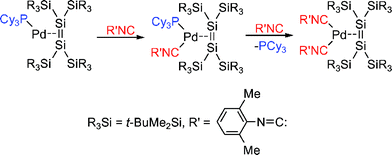Ligand dependence of π-complex character in disilene–palladium complexes†
Abstract
The synthesis and structures of new 16-electron ![[double bond, length as m-dash]](https://www.rsc.org/images/entities/char_e001.gif) Si(SiMe2Bu-t)2}, where L1 = L2 = PhMe2P; L1 = (cyclohexyl)3P, L2 =
Si(SiMe2Bu-t)2}, where L1 = L2 = PhMe2P; L1 = (cyclohexyl)3P, L2 =

* Corresponding authors
a
Department of Chemistry, Graduate School of Science, Tohoku University, Aoba-ku, Sendai, Japan
E-mail:
mkira@si.chem.tohoku.ac.jp
Fax: +81-22-795-6589
Tel: +81-22-795-6585
The synthesis and structures of new 16-electron ![[double bond, length as m-dash]](https://www.rsc.org/images/entities/char_e001.gif) Si(SiMe2Bu-t)2}, where L1 = L2 = PhMe2P; L1 = (cyclohexyl)3P, L2 =
Si(SiMe2Bu-t)2}, where L1 = L2 = PhMe2P; L1 = (cyclohexyl)3P, L2 =

 Please wait while we load your content...
Something went wrong. Try again?
Please wait while we load your content...
Something went wrong. Try again?
T. Iwamoto, Y. Sekiguchi, N. Yoshida, C. Kabuto and M. Kira, Dalton Trans., 2006, 177 DOI: 10.1039/B512414J
To request permission to reproduce material from this article, please go to the Copyright Clearance Center request page.
If you are an author contributing to an RSC publication, you do not need to request permission provided correct acknowledgement is given.
If you are the author of this article, you do not need to request permission to reproduce figures and diagrams provided correct acknowledgement is given. If you want to reproduce the whole article in a third-party publication (excluding your thesis/dissertation for which permission is not required) please go to the Copyright Clearance Center request page.
Read more about how to correctly acknowledge RSC content.
 Fetching data from CrossRef.
Fetching data from CrossRef.
This may take some time to load.
Loading related content
